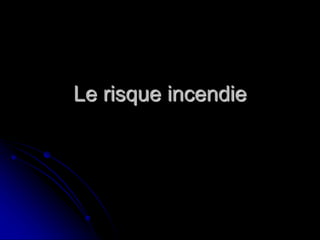Le_risque_incendie.ppt
•Télécharger en tant que PPT, PDF•
0 j'aime•13 vues
Protection contre incendie
Signaler
Partager
Signaler
Partager

Recommandé
Recommandé
More than Just Lines on a Map: Best Practices for U.S Bike Routes
This session highlights best practices and lessons learned for U.S. Bike Route System designation, as well as how and why these routes should be integrated into bicycle planning at the local and regional level.
Presenters:
Presenter: Kevin Luecke Toole Design Group
Co-Presenter: Virginia Sullivan Adventure Cycling AssociationMore than Just Lines on a Map: Best Practices for U.S Bike Routes

More than Just Lines on a Map: Best Practices for U.S Bike RoutesProject for Public Spaces & National Center for Biking and Walking
Contenu connexe
En vedette
More than Just Lines on a Map: Best Practices for U.S Bike Routes
This session highlights best practices and lessons learned for U.S. Bike Route System designation, as well as how and why these routes should be integrated into bicycle planning at the local and regional level.
Presenters:
Presenter: Kevin Luecke Toole Design Group
Co-Presenter: Virginia Sullivan Adventure Cycling AssociationMore than Just Lines on a Map: Best Practices for U.S Bike Routes

More than Just Lines on a Map: Best Practices for U.S Bike RoutesProject for Public Spaces & National Center for Biking and Walking
En vedette (20)
Content Methodology: A Best Practices Report (Webinar)

Content Methodology: A Best Practices Report (Webinar)
How to Prepare For a Successful Job Search for 2024

How to Prepare For a Successful Job Search for 2024
Social Media Marketing Trends 2024 // The Global Indie Insights

Social Media Marketing Trends 2024 // The Global Indie Insights
Trends In Paid Search: Navigating The Digital Landscape In 2024

Trends In Paid Search: Navigating The Digital Landscape In 2024
5 Public speaking tips from TED - Visualized summary

5 Public speaking tips from TED - Visualized summary
Google's Just Not That Into You: Understanding Core Updates & Search Intent

Google's Just Not That Into You: Understanding Core Updates & Search Intent
The six step guide to practical project management

The six step guide to practical project management
Beginners Guide to TikTok for Search - Rachel Pearson - We are Tilt __ Bright...

Beginners Guide to TikTok for Search - Rachel Pearson - We are Tilt __ Bright...
Unlocking the Power of ChatGPT and AI in Testing - A Real-World Look, present...

Unlocking the Power of ChatGPT and AI in Testing - A Real-World Look, present...
More than Just Lines on a Map: Best Practices for U.S Bike Routes

More than Just Lines on a Map: Best Practices for U.S Bike Routes
Ride the Storm: Navigating Through Unstable Periods / Katerina Rudko (Belka G...

Ride the Storm: Navigating Through Unstable Periods / Katerina Rudko (Belka G...
Good Stuff Happens in 1:1 Meetings: Why you need them and how to do them well

Good Stuff Happens in 1:1 Meetings: Why you need them and how to do them well
Le_risque_incendie.ppt
- 2. Conditions de survenue du feu Oxygène de l’air Papier Carton Bois Gaz Essence… Étincelle Flamme Court-circuit…
- 3. Conséquences Sur l’homme, Asphyxie intoxication, Brûlures Sur les biens, Dégradation, destruction de l’outil de travail Effondrement Sur l’environnement Pollutions générées par l’incendie Nappes phréatiques par les eaux d’extinction L’air par les fumées
- 4. Comment éviter la survenue de l’incendie ? •Séparer les produits comburants •Combustibles avec point éclair plus élevé •Séparation lors du stockage •Rationaliser les prises de courant •Séparer les zones avec des flammes •Éviter les étincelles
- 5. Si l’incendie se déclare quand même… Faire évacuer les occupants des bâtiments détection de l’incendie alarme plan d’évacuation sorties de secours signalétique Limiter la propagation de l’incendie obstacles murs et portes coupe-feu choix des matériaux isolement des locaux à risque désenfumage
- 6. Synthèse des principales réglementations incendie Objectif Protection des personnes Protection du voisinage Objet Salariés Occupants Public Environnement Etablissement Etablissements industriels et commerciaux Immeubles de grande hauteur (IGH) Etablissements recevant du public (ERP) Installations classées des établissements dangereux, insalubres ou incommodes Prescripteur Ministère du Travail Ministère de l’Intérieur Ministère de l’Environnement Textes réglementaires Code du travail (articles R. 235-4 à R. 235-4-17, et articles R. 232- 12 à R. 232- 14-1) Arrêté du 18 octobre 1977 modifié Arrêté du 25 juin 1980 modifié Loi du 19 juillet 1976, et décret et arrêtés d’application
- 7. 1ère catégorie > 1500 pers. 2ème catégorie > 700 pers. 3ème catégorie > 300 pers. 4ème catégorie < 300 pers. > seuil par type 5ème catégorie < seuil par type Catégorie Type(s) L M N ……….. U R etc.... Classification des E.R.P.
- 8. Réglementation E.R.P. Règles de construction Murs et portes coupe-feu Détection et alarme incendie Sortie de secours Extinction du feu 1 extincteur mini / 200m² 1 extincteur par danger localisé Évacuation Plan d’évacuation Consignes dans chaque pièce Signalétique Vérification Commission de sécurité Réception de travaux Périodique Présentation des contrôles (extincteurs, gaz, installations électriques…)
- 9. Moyens d’extinctions Extincteurs À eau (avec additif) À poudre Au CO2 RIA (robinet d’incendie armé) Installation fixe d’extinction « sprinkleur » Dispersion de mousse Gaz..
- 10. Différentes classes de feu Classe A : Feux de matériaux solides, généralement de nature organique, dont la combustion se fait normalement avec formation de braises (bois, papier, carton…) Classe B : Feux de liquides ou de solides liquéfiables (alcool, white-spirit, caoutchouc, la plupart des matières plastiques) Classe C : Feux de gaz (méthane, butane, propane…) Classe D : Feux de métaux Classe F : Feux liés aux auxiliaires de cuisson
- 11. Extincteurs/classe de feu Extincteur à eau Extincteur à poudre Extincteur CO2 Feux d’origine électrique
- 12. Le feu s’éteint « dans la première minute avec un verre d’eau Dans la deuxième minute avec un seau d’eau Dans la troisième minute avec une tonne d’eau Apres…… on fait ce que l’on peut ….. »